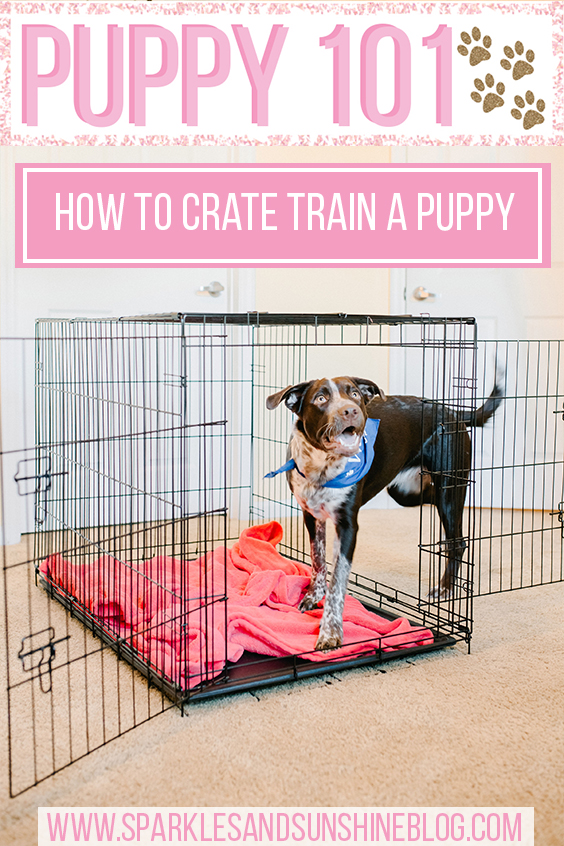How To Crate Train A Puppy
Let’s be honest, crate training a puppy is never fun. They don’t like it, they cry a lot and you feel like a terrible person for putting them in there. However, crate training is very important for a handful of reasons:
- Provides a safe place for your dog.
- Helps them during travel.
- Aids in potty training.
The list really goes on. At the end of the day, it’s always good for your dog to know how to be in a crate. Now, I am a firm believer in only using the crate when necessary. Diesel has full roam of the house during the day (he doesn’t get into anything) and we only use the crate for special circumstances like when the maintenance staff comes to work on the apartment.
A crate for a dog is always supposed to be seen as a safe place that they can go to whenever they want. Today I will be going over the important steps on how to crate train a puppy, my favorite dog crate brand and crate safe dog toys that aid in training.
P.S. If you’re wondering, what the heck should I even get my new puppy? I can help! Check out my entire Puppy 101 section for tons of posts on what to get, and check out my New Puppy Checklist in my Amazon Storefront for my tried and true must-have items!
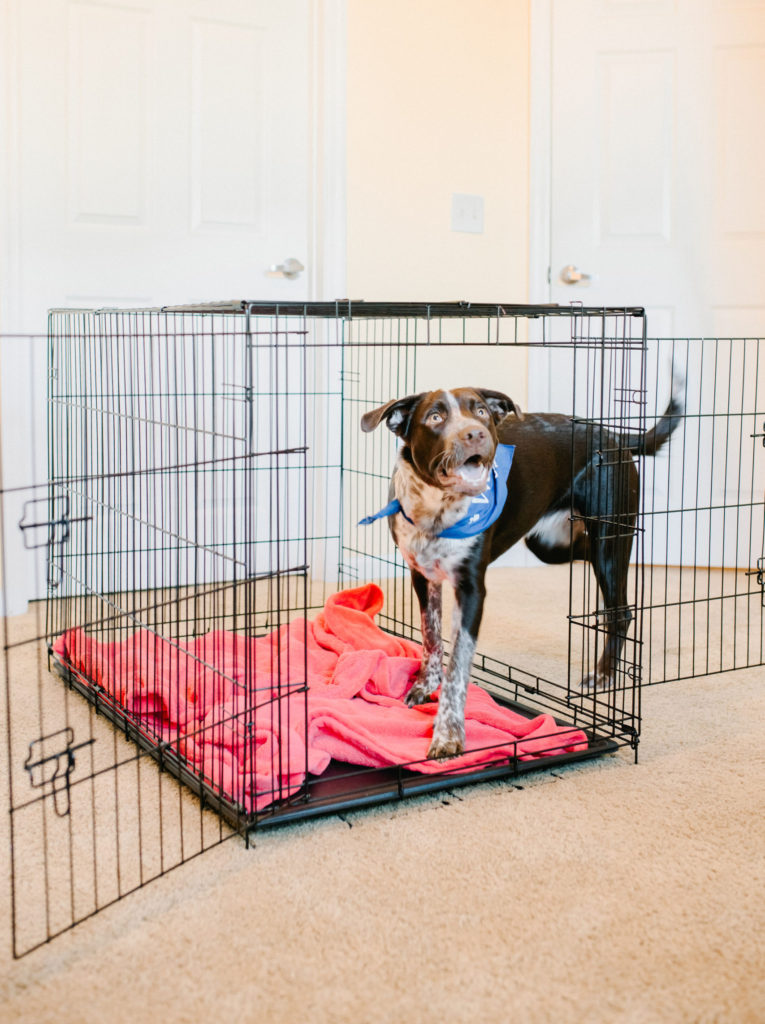
1. Choose The Right Size Crate For Your Dog
When picking out a crate for your dog, there’s only two things to keep in mind:
- Buy a crate for the future size of your dog (i.e. don’t buy a small crate when you have a Great Dane puppy that will outgrow it within a few weeks).
- Buy a strong crate that has a bottom tray.
- My family has always purchased metal crates (puppies can’t chew through that) that have a tray (can be easily slid out from the crate for cleaning).
My favorite dog crate brand is Carlson Pet Products. Carlson Pet Products has dog crates of all sizes, colors and designs. They’re very helpful in showing you what size dog crate you will need by pairing the appropriate dog breed for each size crate. For instance, we knew we needed a large crate for Annie because of the Labrador and Greyhound dogs that were shown in those sizes. Whereas Diesel would be best in the extra large dog crate, where a German Shepherd was shown.
The dog crate featured in this post is the Large Double Door Dog Crate. Double door dog crates are extremely resourceful for a few reasons:
- No matter where you place the crate, there is always a second point of entry for your dog.
- The best example for this is during travel. With suitcases and other items packed around the crate, having two exit points allows for easier and quicker mobility for you and your dog!
- Most double door dog crates come with a divider.
- This is huge for crate training your puppy! Having this divider allows you to break up the crate and gradually increase the size as they get bigger. You never want your puppy to have too much room in their crate from the beginning because puppies view this room as an opportunity to go potty.
I have been using Annie’s new double door dog crate for about a month now and have absolutely loved it! To learn more about this dog crate, and a few other amazing dog products, check out my blog post featuring 4 Must-Have Dog Products From Carlson Pet Products!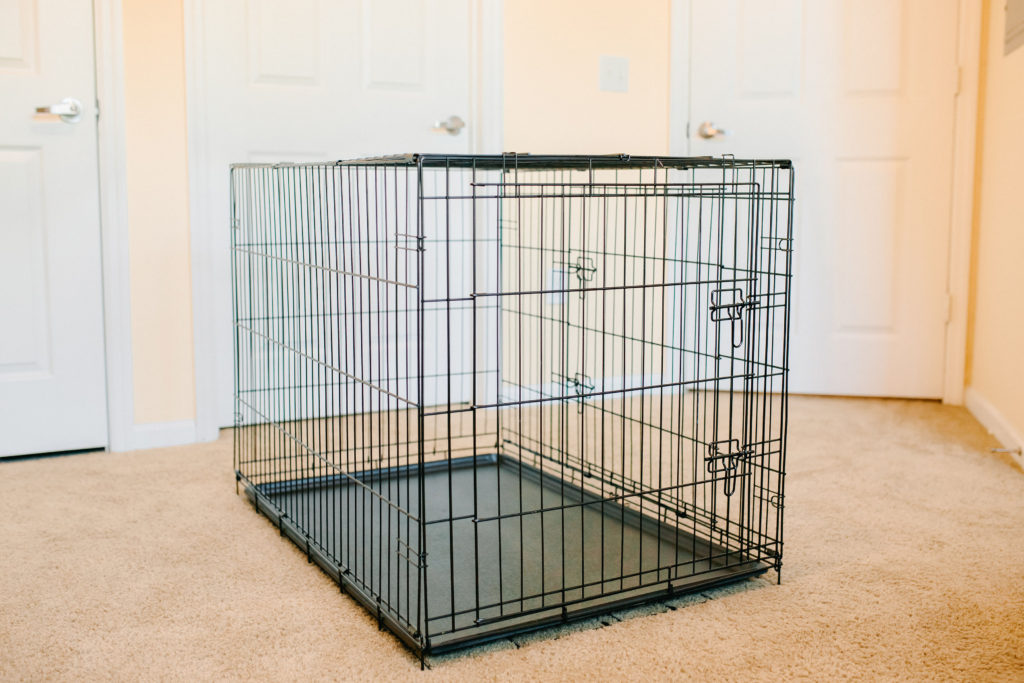
2. Place the Crate In A Central/Common Location
Before you begin introducing the crate to your puppy, you first need to place the crate in a common location. This could be your living room or bedroom. At night, we choose to put the crate in the bedroom right next to our bed so that when Annie is sleeping, we can easily check on her. If you also want your puppy to sleep in their crate at night, I recommend putting either their bed or blanket in their crate with them and depending on their behavior, a plush toy for them to snuggle with. Annie was used to being with her siblings so we wanted to make sure she had a comfy toy to cuddle with at night. During the day, we move the crate to the living room so that she can see Diesel and not feel like she’s far away from everyone and everything.
With Diesel, we kept the crate in the living room because he didn’t use the crate at night. He immediately slept with us in the bed from day one (still does ha). We eventually want to do the same with Annie, but she’s still a little too mischievous ha!
Wherever you put it, make sure it is in a place where they can easily see you and you can see them.
3. Feed Every Meal In Their Crate
Almost all puppies are food motivated, meaning all they want to do is eat. Because of this, the best first way to introduce a crate to your puppy is by having them eat every meal in their crate.
You can start by placing their bowl in their crate and having them eat in it with the door open or almost closed. Since your puppy will be eating three times a day (in the beginning when they’re young), they will have many positive experiences in a crate because they know that if they go in there, they get food.
4. Slowly Add More Time
As your puppy starts to experience more time in the crate from meal time, slowly add on more time for them to be in the crate (with the door closed and fully latched – Annie was an escape artist once ha). Start with five minutes and hang out with them in the room while they’re in there, telling them how good they are, giving them positive praise the entire time. They have to know that it’s a good place.
What I did with Annie was to take her out to go potty before her meal, that way she was good if I wanted to practice a little crate training with her after her meal without the worries of having an accident in her crate. Please note that an accident can still happen and it’s not their fault. You can also take them for a simple walk to get a little energy out so that they are calmer when they go to their crate.
After practicing with five minutes, change it to 10, then 20, etc. The goal is to build up the time in the crate as well as their confidence and feeling of security. Your puppy will start to get used to it, it just takes time. I recommend practicing crate training a minimum of one time a day and a max of two in the beginning. Know that they will whine, a lot, and you just have to ignore it.
5. Introduce Crate-Safe Toys
In addition to food, one of the best things you can introduce to them are interactive toys that provide a reward like a treat. If you’ve been following me for a little while, you know that I am a huge fan of KONG. KONG actually has many puppy products that double as crate training and teething dog toys.
P.S. Have you seen my recent blog post about 3 Durable KONG Dog Toys? Check it out!
My favorite puppy KONG toys that assisted us with crate training are:
a) KONG Classic Puppy
The KONG Classic Puppy toy is a must-have! The best thing to do with this toy is to put some peanut butter in it, put it in the freezer the night before and then give it to them in their crate. By freezing it, you provide a nice cool snack and it takes longer for them to lick it all out.
What I did with Annie, was to give her the KONG Classic Puppy toy in her crate about 10-15 minutes before her lunch meal so she could just be in her crate with a treat. Then once she was done, I would have her lunch ready, put that in there so she would eat her food in her crate and then keep her in there for an additional like 10 minutes after that. At that point, she doesn’t realize she’s been in the crate until after her meal, providing 15-25 minutes of positive crate time!
Keep in mind, this was done after practicing being in the crate a handful of times.
P.S. If you’re wondering, what the heck should I even get my new puppy? I can help! Check out my entire Puppy 101 section for tons of posts on what to get, and check out my New Puppy Checklist in my Amazon Storefront for my tried and true must-have items!
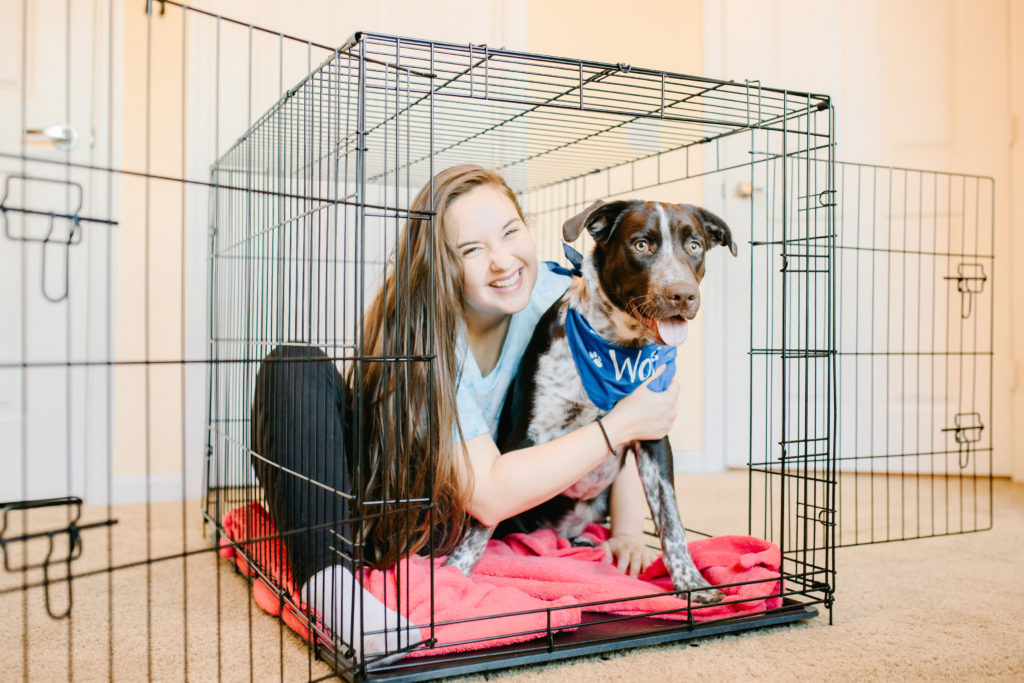
b) KONG Puppy Teething Stick
The second toy that we actually had not tried before until Annie was the KONG Puppy Teething Stick. This is one of those toys that I mentioned that doubles as a crate training and teething toy.
The KONG Puppy Teething Stick has the same rubber material as the KONG classic puppy toy, but this toy features “Denta-Ridges” that soothe their gums and clean their teeth while they chew. These ridges can also be filled with a reward like peanut butter or the KONG Easy Treat Puppy Stuffing. The teething stick, like the KONG Classic Puppy toy, keeps them distracted with something to chew on instead of chewing on their crate.
With either of these toys, I recommend sitting by them while they’re in their crate for the first one or two times, to make sure that they’re okay with the toy and don’t try to destroy it. After that, I walk away into the other room of the house to practice me not being there. The first time Annie got a bit upset but after that she was more excited about her KONG toy since she figured out how to get all of the peanut butter out.
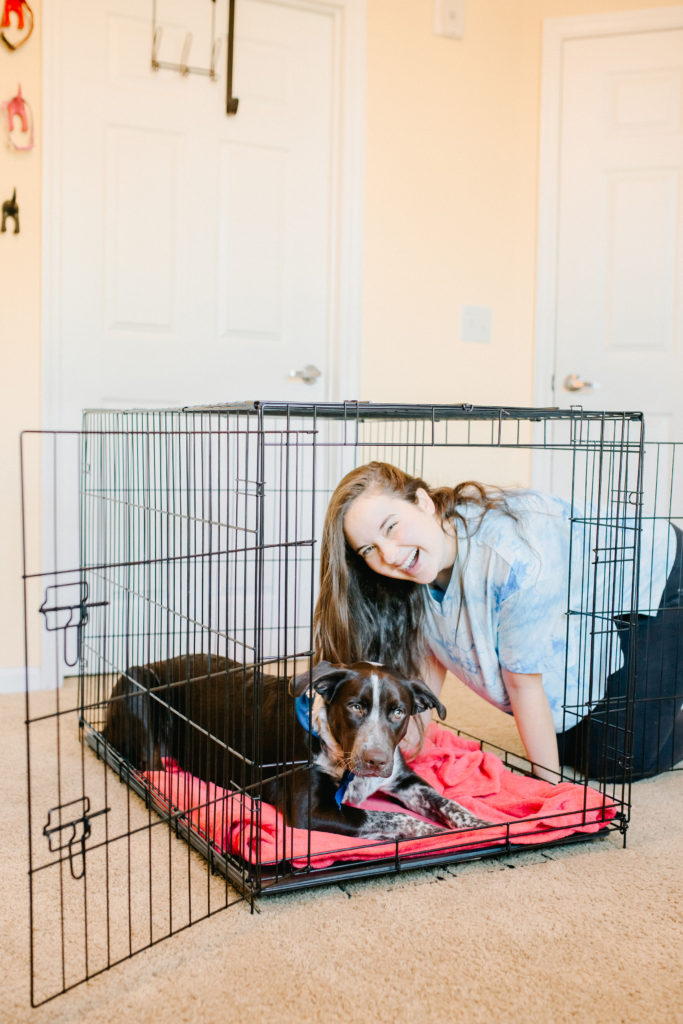
6. NEVER Use The Crate As A Punishment
Last but not least, NEVER use the crate as a punishment. The crate is supposed to be their safe place at all times and if you begin to use it as a place for punishments, that feeling of safety will go right out the window.
There is one exception to this, however. Once they’ve gotten older and have understood certain commands. At that point, if they choose to not listen, they can be put in their crate for what we call a “time-out.” This isn’t a super long period of time, usually only a few minutes because that’s all you need to get your point across.
Thanks for reading my post about how to crate train a puppy. I hope these tips were super helpful, and if you have any questions, please share in the comments below! I’d love to help answer any question you have!
If you loved learning these helpful puppy training tips, check out some of my other posts about puppy tips and puppy training like:
- How To Potty Train A Puppy
- 3 Stages Of Puppy Teething
- How To Puppy Proof Your Home & Yard
- 10 Items To Buy For Your New Puppy
- What To Know Before Getting A Puppy
Plus, don’t forget to check out some of my most recent posts below:
*Thank you Carlson Pet Products for providing the Large Double Door Dog Crate for this post*
Photography: Kate Kelley Collection
Want to save this information on how to crate train a puppy for later? Save the image below to your Pinterest board to have on hand!
Pin this!
